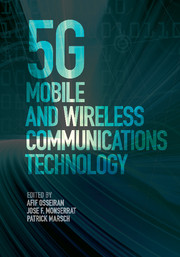Book contents
- Frontmatter
- Dedication
- Contents
- List of contributors
- Foreword
- Acknowledgments
- Acronyms
- 1 Introduction
- 2 5G use cases and system concept
- 3 The 5G architecture
- 4 Machine-type communications
- 5 Device-to-device (D2D) communications
- 6 Millimeter wave communications
- 7 The 5G radio-access technologies
- 8 Massive multiple-input multiple-output (MIMO) systems
- 9 Coordinated multi-point transmission in 5G
- 10 Relaying and wireless network coding
- 11 Interference management, mobility management, and dynamic reconfiguration
- 12 Spectrum
- 13 The 5G wireless propagation channel models
- 14 Simulation methodology
- Index
- References
8 - Massive multiple-input multiple-output (MIMO) systems
Published online by Cambridge University Press: 05 June 2016
- Frontmatter
- Dedication
- Contents
- List of contributors
- Foreword
- Acknowledgments
- Acronyms
- 1 Introduction
- 2 5G use cases and system concept
- 3 The 5G architecture
- 4 Machine-type communications
- 5 Device-to-device (D2D) communications
- 6 Millimeter wave communications
- 7 The 5G radio-access technologies
- 8 Massive multiple-input multiple-output (MIMO) systems
- 9 Coordinated multi-point transmission in 5G
- 10 Relaying and wireless network coding
- 11 Interference management, mobility management, and dynamic reconfiguration
- 12 Spectrum
- 13 The 5G wireless propagation channel models
- 14 Simulation methodology
- Index
- References
Summary
Introduction
As stated in Chapter 2, one of the main 5G requirements [1] is to support 1000 times larger capacity per area compared with current Long Term Evolution (LTE) technology, but with a similar cost and energy dissipation per area as in today's cellular systems. In addition, an increase in capacity will be possible if all three factors that jointly contribute to system capacity are increased: More spectrum, a larger number of base stations per area, and an increased spectral efficiency per cell.
Massive or large Multiple-Input Multiple-Output (MIMO) systems are considered essential in contributing to the last stated factor, as they promise to provide a substantially increased spectral efficiency per cell. A massive MIMO system is typically defined as a system that utilizes a large number, i.e. 100 or more, of individually controllable antenna elements at least at one side of a wireless communications link, typically at the Base Station (BS) side [2][3]. An example of such usage of massive MIMO at the BS side is shown in Figure 8.1. A massive MIMO network exploits the many spatial Degrees of Freedom (DoF) provided by the many antennas to multiplex messages for several users on the same time-frequency resource (referred to as spatial multiplexing), and/or to focus the radiated signal toward the intended receivers and inherently minimize intra-cell and inter-cell interference [4]–[7]. Such focusing of radiated signals in a particular direction is possible by transmitting the same signal from multiple antenna points, but with a different phase shift applied to each of the antennas (and possibly a different phase shift for different parts of the system bandwidth), such that the signals overlap coherently at the intended target location. Note that in the remainder of the chapter, the term beamforming is used when applying the same phase shift at individual transmit antennas over the entire system bandwidth, while the term precoding is used when applying different phase shifts for different parts of the system bandwidth to tackle small-scale fading effects, for instance by applying phase shifts in frequency domain. With this definition, beamforming can be seen as a subclass of precoding algorithms. Regardless of whether precoding or beamforming is applied, the gain of obtaining a coherent overlap of signals at the receive point is commonly referred to as array gain.
- Type
- Chapter
- Information
- 5G Mobile and Wireless Communications Technology , pp. 208 - 247Publisher: Cambridge University PressPrint publication year: 2016
References
- 4
- Cited by



